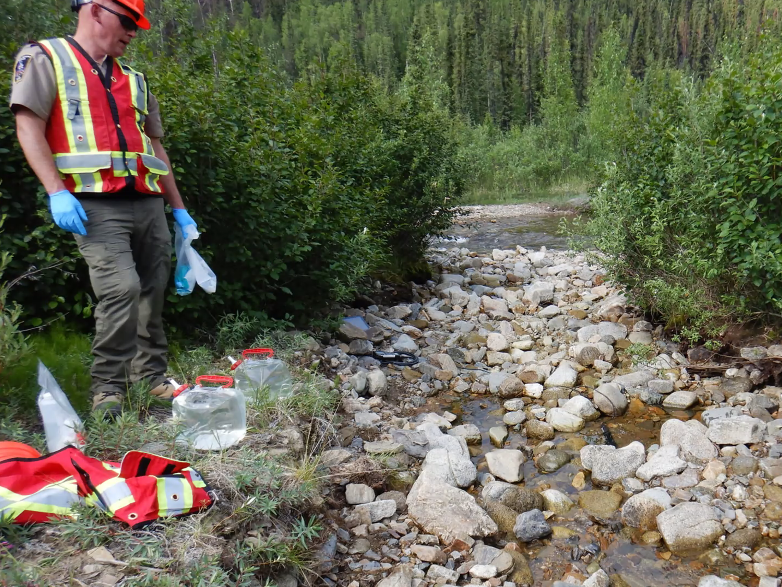
The sudden collapse of Victoria Gold Corp.’s Eagle Mine — and with it, the company — is part of a long and ugly history in northern Canada.
To this day, Canada’s federal government is still cleaning up arsenic and cyanide spills from mines that were abandoned by their owners decades ago. The country’s taxpayers are footing the bill.
Victoria Gold’s Eagle Mine, which closed in June after its gold-processing facility collapsed and spilled cyanide into the surrounding rivers, will cost about C$150 million ($111 million) to restore, according to preliminary estimates from Yukon Territory, a region of just 46,000 people that borders Alaska. But if history is any guide, the cost may turn out to be much higher, warn activists and industry watchdogs.
“Cost overruns are perfectly normal in this business, and all of it gets paid by the taxpayer,” said Jamie Kneen, head of Mining Watch Canada, an advocacy group. “I wouldn’t at all be surprised to see it cost much more than what’s currently being said, just because we have constantly seen that these problems cost several times the original estimate.”
Canadians are still on the hook for long-forgotten mining disasters in the Yukon, which has been a hub for gold miners since the Klondike Gold Rush more than a century ago.
The Yukon’s Faro Mine — roughly the size of Albany, New York and once the world’s largest open pit lead-zinc mine — was abandoned in 1998 and is still undergoing an extensive and complicated remediation process today. In 2002, Canada’s government projected the remediation to cost around C$200 million; in 2022, it revised the figure to C$5 billion.
Giant Mine, a similarly abandoned gold mine in the neighboring Northwest Territories, is now projected to cost C$3.9 billion to clean, according to Canada’s environment department.
Yukon’s government said the cost of the Eagle Mine cleanup will be covered through government loans to accounting firm PricewaterhouseCoopers, which was assigned to manage Victoria Gold after the mining company was placed into receivership in August. It began lending funds for the cleanup last month, advancing C$50 million to PwC to cover the first stages of remediation.
The loans are supposed to be repaid later through sales of Victoria Gold’s assets, the value of which is being determined by PwC, according to Yukon officials.
“We recognize concerns regarding potential costs to taxpayers following the Eagle Gold Mine heap leach failure, which is why we pushed for receivership to help prevent this issue,” Yukon government spokesperson Laura Seeley said in an emailed statement. “Receivership helps prevent taxpayers from covering cleanup costs by prioritizing the use of Victoria Gold’s financial resources and assets to fund the work.”
Finding buyers for a distressed mining firm’s operations, however, is no guarantee. PwC ultimately failed to find a buyer for the nearby Minto copper-gold mine last year after it was assigned the receiver to the asset, which had been abandoned by its owners. It also failed to find a buyer for the Wolverine Mine, a zinc operation, after acting as receiver of the Yukon operation since 2019.
Eagle Mine was Victoria Gold’s sole operating mine, and the company owns few other significant assets that could generate enough to repay Yukon’s government.
PwC didn’t respond to requests for comment.
“We have very few examples, in recent memory, of successfully reclaimed mines,” Kate White, leader of the Yukon’s official opposition party, the New Democratic Party, said in an interview.
The disaster has prompted officials to revisit its regulatory approach to mining in the territory. In the wake of the collapse, Yukon’s government suspended the issuance of new licenses tied to gold processing, pending the outcome of an independent review of the spill at Eagle Mine.
(By Jacob Lorinc)
2 Comments
Eric Cruise
Doesnt Canada require a reclaimation bond for all mining projects ? Seems like this would be standard. No permit issued until firm presents a plan of development and reclaimmation. Independent office determines cost of future reclaimation and firm bonds that amount. Plan is reviewed and updated regularly. If mining firm goes belly up, bond covers costs.
Ken Harrison
These big mines are old mines , mined before reclamation bonds were mandated